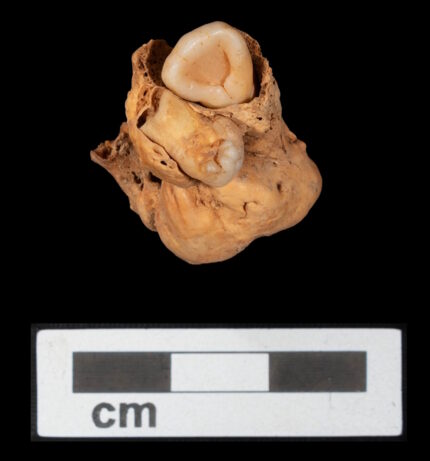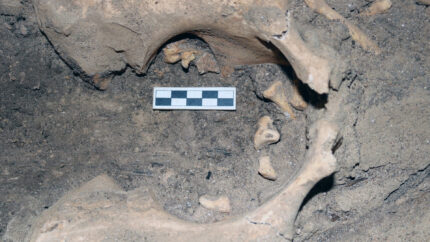 A calcified ovarian teratoma has been discovered in the grave of a young woman in a New Kingdom cemetery in Amarna, Egypt. This is the fifth known example of an archaeological teratoma and by far the oldest of them, dating to around 1340 B.C. It is also the first one discovered in Africa.
A calcified ovarian teratoma has been discovered in the grave of a young woman in a New Kingdom cemetery in Amarna, Egypt. This is the fifth known example of an archaeological teratoma and by far the oldest of them, dating to around 1340 B.C. It is also the first one discovered in Africa.
Teratomas are tumors, almost always benign, in which germ cells randomly grow malformed body parts like bone, teeth and hair. They are typically found in the reproductive organs where germ cells that haven’t gone awry make sperm and eggs, and much more frequently in the ovaries than the testicles. The previous archaeological teratomas on record (5th centuty B.C. Spain, 5th century A.D. France, 16th-17th century Peru, 15th-18th c. Portugal) were all ovarian. The most recent discovery is an ovarian teratoma as well.
The skeletal remains of a woman between 18 and 21 years old when she died were unearthed in a multi-chambered shaft room in Amarna’s North Desert Cemetery last year. The calcified mass with two deformed teeth was discovered inside her pelvic cavity above the plant fiber burial mat, indicating it was inside her body when she was buried, not an artifact of deposition.
 It was unusually rich for a burial in the non-elite cemetery, containing several grave goods. One of them was a ring engraved with an image of the god Bes, protector of the household, mothers, children and childbirth. The ring was on her left hand which was placed over her pelvis above the teratoma. This may be an indication that it may have been causing physical problems. Most teratomas are asymptomatic, but depending on their size, shape and location in the body, they do occasionally cause pain, organ movement, infections, lesions, anemia and other problems. If she had ovarian pain, Bes may have been invoked to keep her reproductive organs in good working condition.
It was unusually rich for a burial in the non-elite cemetery, containing several grave goods. One of them was a ring engraved with an image of the god Bes, protector of the household, mothers, children and childbirth. The ring was on her left hand which was placed over her pelvis above the teratoma. This may be an indication that it may have been causing physical problems. Most teratomas are asymptomatic, but depending on their size, shape and location in the body, they do occasionally cause pain, organ movement, infections, lesions, anemia and other problems. If she had ovarian pain, Bes may have been invoked to keep her reproductive organs in good working condition.
“By 18-21 years, this individual probably would have been someone’s wife,” [Southern Illinois University Carbondale bioarchaeologist Gretchen Dabbs told Live Science in an email, but there is also “little doubt she was working in some fashion.” Previous research at Amarna has suggested that women this age were engaging in a range of trades, which might have included working on state-level building projects, brewing beer, or tending to household gardens and livestock.
The discovery has been published in the International Journal of Paleopathology.
Interestingly one tooth has the look of a shoveled incisor although this may just be a developmental aberration. I wonder what the teeth in her mouth look like. I bring all this up simply because shoveled teeth would be very uncommon in an Egyptian.